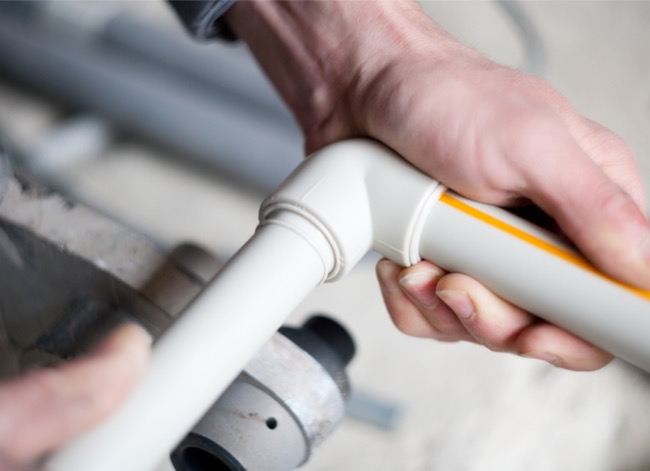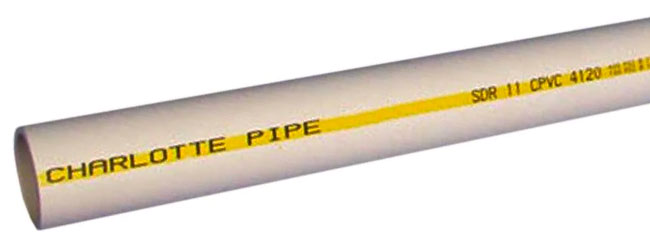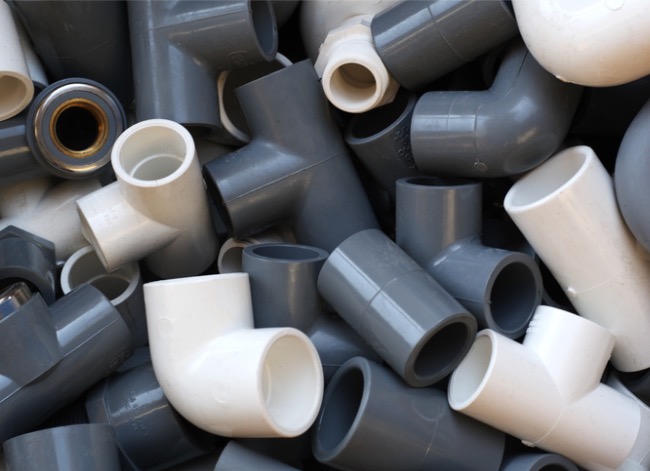We may earn revenue from the products available on this page and participate in affiliate programs. Learn More ›
Q: I often see CPVC when I’m shopping for products for my home, but I don’t know what it is. What is CPVC and what is it used for?
A: This is a good question, and one that many DIYers have been asking in recent years. Before explaining CPVC, it’s helpful to understand PVC. The term PVC stands for polyvinyl chloride, and it’s a durable, man-made plastic with many uses. During the manufacturing process, stabilizers are added to help the plastic resist oxidation and degradation.
“CPVC” stands for chlorinated polyvinyl chloride. If that seems redundant, there’s a reason: the manufacturing process further chlorinates the plastic and changes its chemical composition. Without an in-depth chemistry lesson, this allows CPVC to be more resistant to degradation and improves its lifespan. However, both PVC and CPVC are popular plumbing pipe compounds, but they’re not exactly interchangeable.
CPVC and PVC are both plastics, but CPVC is more durable and longer-lasting.
While it’s true that the names are similar, and the two products even look similar, there are some significant differences between CPVC and PVC.
The chemical makeup of CPVC makes it far more resistant to corrosion and degradation over time than PVC, but it’s also better suited for higher temperature applications. PVC’s maximum operating temperature is 140 degrees. Beyond that temperature, the plastic softens and loses its shape, which can lead to leaks. However, CPVC has a maximum operating temperature of 200 degrees before it softens.
Also, CPVC and PVC react to chemicals differently. Not only is CPVC better suited for chemical applications, the solvents and primers used to bond these materials are different. Both require a specific type.
RELATED: How to Paint PVC Pipe

CPVC is chemical-resistant, flexible, and strong.
It’s safe to consider CPVC as a superior material to PVC. While both are strong, impact-resistant, and somewhat flexible, CPVC excels at each of these characteristics.
The manufacturing process makes CPVC resistant to chemicals and degradation, allowing it to last a long time. This makes it useful in commercial and industrial settings, where chemicals and high temperatures are more likely to be present.
CPVC also is more flexible than cast iron or copper pipe. This flexibility makes it easy to work with, and there is a bit of give when encountering joints that aren’t perfectly aligned. Its flexibility also makes this product impact-resistant, further improving its durability.
For the most part, CPVC is used in plumbing products.
Both CPVC and PVC are capable of many of the same tasks, but CPVC is much more expensive. For that reason, CPVC is mostly used in plumbing applications at places like factories where chemical and heat resistance matter, while manufacturers use PVC in many kinds of consumer goods.
CPVC is used to create commercial- or industrial-grade pipes for liquid distribution as well as the fittings to secure them. These pipes are often used to replace copper or cast iron, and can serve many of the same purposes. CPVC also can be used as vent piping when necessary, but only when venting air temperatures that are less than 200 degrees.

RELATED: How to Connect PEX to Copper or PVC
There are different types of CPVC pipes.
CPVC isn’t a one-size-fits-all product. While it’s available in pipes of different diameters, those diameters can vary. PVC is available in nominal sizes, known as NPS (nominal pipe size). CPVC is available in both nominal widths and copper tube sizes (CTS). NPS describes the size of the interior diameter of the pipe, and CTS describes the size of the outside of the pipe.
Also, CPVC is available in both Schedule 40 and Schedule 80, and this describes the thickness of the pipe’s wall. Though they have the same chemical resistance and heat range, Schedule 40 is thinner than Schedule 80, giving Schedule 40 a bit less strength but it’s slightly more flexible. CPVC also comes in three colors, including off-white, light gray, or yellow.

CPVC isn’t just for industrial and commercial settings.
There are more uses for CPVC pipes than just factories and commercial buildings. CPVC works very well as a potable water distribution pipe, making it an ideal choice for residential plumbing applications.
While there aren’t many codes that require CPVC, its long-lasting and durable characteristics make it an excellent choice in residential settings. If there’s a reason not to use it, it’s the price. CPVC is sometimes six times more expensive than PVC. For that reason, many plumbers and DIYers choose to only use it for the hot water distribution pipes, leaving the cold water for PVC piping. Both types are recognized by most plumbing codes.

